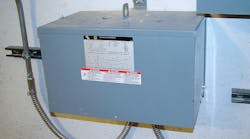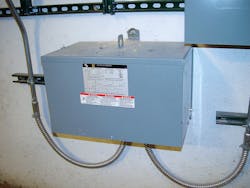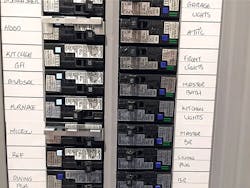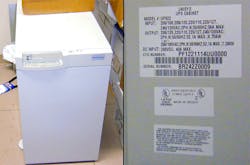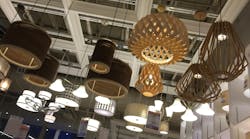As an electrical Code enforcement official, my goal is to help you understand the impact of markings and installation instructions — especially when it comes to ratings, sizing, and product markings (Photo 1). Let’s look at some marking examples to test your knowledge.
Short-circuit Current Ratings
Sec. 110.10 of the National Electrical Code (NEC) requires designers, installers, and authorities having jurisdiction (AHJs) to consider short-circuit current ratings (SCCRs) along with other circuit characteristics to ensure protective devices clear faults without excessive damage to equipment. We must assume that all molded-case circuit breakers are required by UL 489, Molded-Case Circuit Breakers, Molded-Case Switches, and Circuit-Breaker Enclosures, to have that rating marked on the device. How difficult should it be to see that marking when the breaker is installed? Without removing covers, can you determine the rating of a device (Photo 2)?
Photo 1. Manufacturers’ product markings and nameplates play a huge role in the AHJ’s ability to evaluate electrical products on the job site.
Photo 2. Can the markings on these overcurrent devices be properly observed by the AHJ without removing the panelboard cover?
It’s obvious that marking circuit breakers with a QR code, a barcode, or some other means could provide those in the field with needed information specific to the scanned product, and technology makes that type of marking a realistic option today. Most electrical professionals working in the field carry a smartphone or tablet PC to complete their work. I realize this may raise concerns with some stakeholders, such as:
• Who would monitor and confirm accuracy of the data included?
• If a standard format to present data was developed, would all stakeholders be able to easily enter their specific information into that format?
• Who and how would the data be protected?
• Would every stakeholder have access to the data from every electrical installation?
• Which stakeholder group would be willing to accept the cost of developing the “data system” as technology and equipment is revised and updated?
• How accurate would the data be?
Together, those in the industry could work through the concerns. It also seems the need to have field access to critical equipment information — without having to remove covers or search the Internet — might outweigh many or all of those concerns.
Access to and accuracy of data is critical, regardless of the delivery means. If the concept has merit and provides value, one of the industry organizations may be willing to host the effort to develop the concept. It seems that collectively, we as an industry must identify a potential host organization and place the concept on the agenda.
Sizing Conductors and Overcurrent Protective Devices
In our second example, let’s look at sizing the supply conductors and overcurrent protective device to uninterruptible power supplies (UPSs) equipment that is rated not more than 600V (Photo 3).
Photo 3. The input and output current information on the nameplate is a critical part of the puzzle in determining minimum conductor size and proper sizing of overcurrent protection devices.
If we consider a supply circuit to be a branch circuit, Sec. 210.19(A) appears to include the conductor sizing requirements. We simply need to know if the load is continuous or noncontinuous. The conductor size will be based on the product nameplate and information provided in Sec. 210.19. Sizing the overcurrent protective device for that branch circuit is covered in Sec. 210.20 and appears also to be based on continuous or noncontinuous use and the product nameplate.
If we determine the supply circuit is a feeder, we can find the NEC requirements for conductor sizing in Sec. 215.2 and the overcurrent protective device in Sec. 215.3. Interestingly, the continuous or noncontinuous considerations are the same as those for branch circuits.
Get Familiar with Product Markings
I encourage you to take a trip to your local big box or home supply store and spend some time reviewing the electrical supplies they sell, along with their associated markings and installation instructions. This time will provide value in understanding the marking and instruction challenges that exist today.
Look at similar products produced by multiple manufacturers. Remember that all manufacturers are complying with the marking and installation instruction requirements of the NEC and applicable product standards. However, those items vary significantly from one spot on the shelf to another. This doesn’t necessarily mean any of them are wrong; they’re just different.
The International Association of Electrical Inspectors (IAEI) can be a valuable resource. The Association has local chapters and divisions across North America. Many of those groups hold regular local meetings that could be limited to a few hours or a half day, and can help educate you and offer networking opportunities.
Cook is the Chief Electrical Inspector for Shelby County, Ala., and a member of the International Association of Electrical Inspectors (IAEI). Cook was the IAEI representative and Chairman of NEC CMP-17 for the 2020 NEC. Since 2010, Cook has served on the NFPA Board of Directors.
